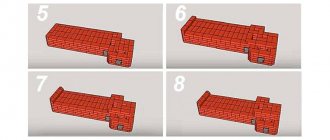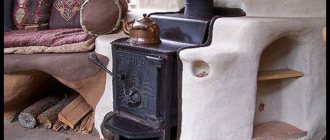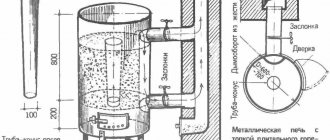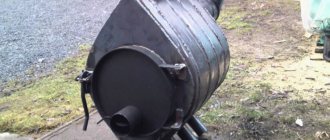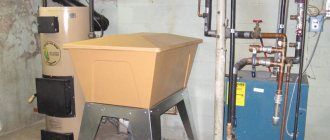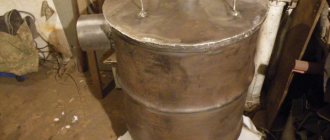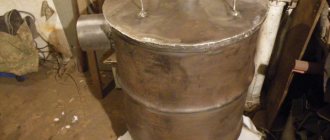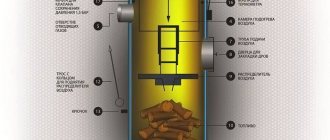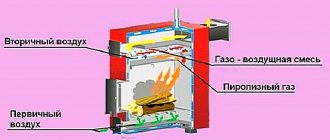Here you will learn:
- Structural features of furnaces
- Advantages and disadvantages
- Types of long-burning stoves
- Making your own oven
- Making a potbelly stove
- We make “bubafonya”
- Increasing efficiency
Wood stoves are actively used to heat premises for various purposes - these can be living rooms, outbuildings, garages and much more. Gas cannot be carried everywhere, which supports the demand for solid fuel units. After all, firewood is a fairly cheap source of heat, and in some cases even free. If we make a long-burning stove with our own hands and install it indoors, we will have at our disposal an easy-to-use unit.
In this review we will look at:
- Operating principle of long-burning furnaces;
- Their advantages and disadvantages;
- the most efficient wood stove designs;
- how to make a good stove with your own hands.
After reviewing the information presented and the homemade drawings, you can independently assemble a slow burning stove for a garage, cottage, outbuilding and any other buildings.
Description and types of long-burning furnaces
Long-burning stoves save coolant by burning gases released during combustion.
The unit is convenient to use, because after loading you can not open the firebox for a long time. When wood or coal burns, flammable gas is released, which is collected in a chamber where it burns and releases energy.
Such devices are used in private homes, cottages, garages, and enterprises.
Based on functionality, stoves are divided into equipment for heating, cooking, and combined options are used. The materials are metal, cast iron, brick. For year-round use, it is better to choose a brick fireplace with combined action. A good option would be a homemade “bubafonya” stove made from a gas cylinder.
Classic oven
The complex design requires the presence of an internal coal combustion chamber. It contains a chamber connected to a hood for combustion of the released gases.
The fuel is ignited from below, the gases enter the bell and burn. The classic is manifested in pushing flammable gases through a mass of fuel into a chamber where air is supplied. These types include stoves: Buleryan, Butakov stove.
Shaft furnace
In the unit, the combustion area is shifted to the grate zone. The gases exit through the adjacent compartment, where they burn out and release heat. The best material is brick.
Contains:
- kokoshnik for loading the charge and removing gases;
- furnace shaft;
- bugle;
- lance for supplying gases.
The equipment has a high efficiency coefficient and high productivity.
Hearth oven
The fuel is ignited in it from above, the fire moves down. Air is supplied under the burnt layer through special channels. The simple and effective design comes in a variety of models that are easy to make yourself.
Gas generating furnaces
Provides for slow combustion of gases separated on the basis of pyrolysis. Wood fuel burns under the influence of heat and a small amount of oxygen, releasing flammable gases. The unit must have a heat exchanger. Suitable for heating with the connection of one or two circuits.
Area of use – from garage to home
How can I use a long-burning heating stove? The choice of design option depends on the intended tasks. If the unit is required for a home or cottage, it is better to use stoves with a water jacket. They combine conventional stove heating and water heating. Water carries thermal energy throughout the system, heating the room. At the same time, the furnace body warms up, which increases the efficiency of heat transfer.
Can be used in the garage, bathhouse or home
In a long-burning boiler, the water quickly cools down when the combustion process stops, and the batteries become cold. But the oven cools down more slowly, still giving off heat little by little. For a summer residence, a stove combined with water heating is preferable to solid fuel boilers. It includes a coil in which water is heated. Sometimes it is installed directly into the firebox, which is unsafe. The high temperature generated by the combustion of gases can cause the water to boil and destroy the coil.
It is better to install a water heating coil in the chimney hood. This solution is suitable for heating a summer house, increasing heat transfer. The design of the unit is chosen taking into account the area of the room. For a small bathhouse, garage, or greenhouse, you can use a stove without a water circuit. An air-heating stove in a bathhouse is convenient because it allows you to adjust the combustion intensity. It warms up a small room well, which is good for a bathhouse, but not suitable for a home with permanent residence.
Design features and principle of operation
Types of fuel for pyrolysis boilers and furnaces
The advantages of the equipment are high efficiency, absence of complex automation, energy independence, safety compared to boilers running on gas and liquid fuel. Pyrolysis units give a useful indicator of 90%. Long-burning stoves show a result of 75 - 80% due to the interaction of the housing with the water pipes of the heat exchanger.
The disadvantage is the high cost of finished units.
Wood fuel is placed in the firebox, which burns out quickly. A period of intense combustion (1 hour) is needed to heat the boiler and chimney. Then the furnace is loaded to the top with fuel, the door is closed tightly, and the gate valve is closed to minimize air supply and draft. Under these conditions, good combustion is ensured with the release of flammable gas.
The smart stove runs on coal or brown coal, peat, you can use firewood of various types and waste from wood processing. Sawdust and shavings are used to make pellets and briquettes. They use modern types in the form of pallets and Euro-firewood. There are boilers converted for liquid fuel.
Types of solid fuel for pyrolysis stoves
Of course, dry wood is considered the best choice of fuel for such a heating unit. But since one of the main reasons for installing long-burning appliances is to save money on heating the home, other types of combustible materials that are constantly at hand by the owners are also suitable.
In addition to them, coal is suitable, but this natural fuel is capable of generating powerful thermal energy. When used, it must be loaded into units with thick steel casing walls, otherwise they will quickly become unsuitable for use.
Materials and tools
Long-burning stove from an old gas boiler.
Iron barrels and gas cylinders (50 - 100 l) are used. The air supply channel is made of a steel pipe, the smoke exhaust channel is made of iron or ceramic. For the lid, take sheet steel 3 - 5 mm. Prepare the door and hinges for it. The water circuit is made of sheet iron and two threaded pipes.
To work you need welding, a grinder, a drill, a file, a hammer, an anvil, and a measuring tool.
Chimney device
When it comes to heating equipment that runs on solid fuel, it is imperative to install a chimney. In this case, the chimney is made from a pipe with a diameter of 100 mm.
At a distance of 50–100 mm from the upper edge of the stove, a chimney pipe is cut in. This is a length of steel pipe into which the chimney will fit tightly. The smoke channel is made with a small horizontal section - 50 - 60 cm of a straight pipe is enough to weaken the draft. A large number of knees before leaving the premises is not allowed.
A chimney made of several sections is easy to use. This way you can clean it without any problems.
Important! Sections of the prefabricated chimney pipe are assembled in the direction opposite to the movement of gases.
Calculation of basic parameters
Indicators are selected for the effective use of the firewood loading area and ash collection chamber. The parameters determine that the afterburning area of the emitted gases works effectively. The correct thickness of metal is chosen for the body to extend service life.
Furnace size
The height of the furnace is no more than 1.0 m; the operating time of the equipment depends on this indicator. It is inconvenient to load briquettes into a tall structure, it does not provide effective traction, and the combustion goes out.
The diameter is selected following a proportionality ratio from 1:3 to 1:5 (height, cross-section, respectively). A firebox with a diameter of about 0.3 m works optimally. Narrow chambers are not recommended, because the air from them is drawn into the pipe, which reduces the power of the homemade product.
Material thickness
Long-burning stove made of two cylinders
This criterion is important, because the thin metal of the body will burn out faster. Choose steel for the furnace walls that is no less than 5 mm thick. The parameter is especially important for the boiler version with a water heat exchanger.
Thin walls up to 5 mm contribute to a loss of power, a drop in temperature, and a decrease in the intensity of gas combustion. As a result, heat generation is reduced.
Steel plate parameters
The iron element simultaneously serves as a partition and heating platform for the ignition of pyrolysis gases. The optimal size is when the gap from the outer edge to the inner surface of the unit is 5% of the total diameter.
Outlet pipe parameters
More often they are made of a round steel pipe to remove combustion products of fuel and gases and remove condensate. It is not advisable to use square sections to reduce soot accumulation.
The diameter of the outlet pipe is taken at the level of 80 - 100 mm.
Air supply pipe dimensions
For a homemade stove design, a metal pipe with a diameter exceeding 50 mm is used. Most often they set 70 - 80 mm. The pipe is welded in the middle of the steel circle, matching it with its hole. The result is an element called a piston.
DIY oven
To make a stove you will need a welding machine.
Use any steel containers with the required wall thickness. Metal is used most often; sometimes craftsmen build stoves from brick. Iron structures have the advantage that they can be rearranged if necessary.
Bubafonya stove from a gas cylinder
The top of the container is cut off with a grinder at the point where the walls of the container are rounded; the part is used as a lid. An iron strip is welded to the cut for its stability.
For the pressure piston, a circle is cut out of steel so that it can pass inside the cylinder, a 5 cm hole is formed in the middle. The supply air pipe is connected to the hole by welding. A channel is welded crosswise to the reverse side. Install a chimney at the top and side, clean the cut seams with a grinder. A do-it-yourself long-burning stove made from a gas cylinder is ready.
Long-burning brick stove
Long-burning brick stove
This type of stove looks the most advantageous, but requires more labor during construction and more time.
A solid foundation is built regardless of the base of the house; its dimensions exceed the dimensions of the stove by 20 cm on each side. A sand and crushed stone bedding is made under the sole, and a layer of roofing felt is laid.
After concreting, you can lay the stove for 28 days. The top of the foundation is insulated from the masonry with roofing felt in 3 layers, and a heat-resistant coating made of asbestos and glass-ceramic materials is installed.
The arrangement of bricks in each row is necessary to ensure the effective operation of the structure. Layout drawings can be found on the Internet, where the method of laying each tier is indicated.
The gases inside move not only vertically, but also horizontally. Proper laying of rows increases the plane of contact of smoke with brick and increases the return of thermal energy.
How to improve the oven
Modernization is about ease of use. An iron stove weighs a lot (150 - 160 kg), and to clean it from ash it needs to be turned over. An improvement is to install doors through which combustion residues can be removed.
Modernization of the Bubafonya stove
The peculiarity of the unit is the absence of gaps and tightness, therefore, when installing the doors, insulation must be done. First, the iron sides in the opening are welded, then heat-resistant seals are used.
Cross-shaped pieces of channel under the base of the piston are replaced with metal plates to improve air flow. This way the flow will not swirl, but will be distributed rhythmically in the combustion chamber.
Modernization of a brick kiln
A triangular-shaped stove is made to be installed in the corner of the room. Less brick will be needed for laying, which will save the owner money.
The second option would be to install a separating damper to switch between summer and winter use.
Features of operation
The duration of combustion is regulated by the supply air valve.
Reduce the volume of supplied air to reduce the rate of firewood burning. You can avoid the appearance of condensation if you make fewer turns of the smoke exhaust manifold channel.
The moisture content of the added fuel should not exceed 25%. During combustion, do not open the door to prevent carbon monoxide from entering the room.
Twice a month you need to heat the unit at maximum mode to burn off slag deposits on the internal walls. The efficiency of the stove will be higher if you use large-sized firewood.
Drying
For drying, we put a maximum of 2 kg of firewood in the combustion chamber, light it, and after burning, remove all the ash and remnants of firewood from the firebox and ash pans. After the surfaces have completely cooled, we repeat the work. So we carry out up to 3 drying operations per day for 3-4 days.
When burning wood for the first time, the stove will smoke heavily. Don’t be alarmed, this will evaporate moisture from the ceramic and burn off dirt and grease from the surfaces of the hob and other metal parts. All doors and windows in the room must be open.
On the second day, we begin to examine all surfaces for defects and places where smoke can pass through. If detected, these places are cleared of mortar and sealed with fireproof sealant and fireclay clay solution.
